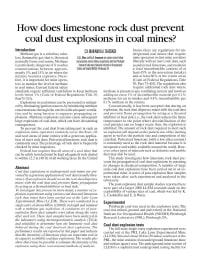Mining Publication: How Does Limestone Rock Dust Prevent Coal Dust Explosions in Coal Mines?
Original creation date: September 2009
Authors: C Man, KA Teacoach
Coal dust explosions in underground coal mines are prevented by generous application of rock dust (usually limestone). If an explosion should occur, the rock dust disperses, mixes with the coal dust and prevents flame propagation by acting as a thermal inhibitor or heat sink. To investigate this process in more detail, a number of explosion experiments using various coal dust and limestone rock dust mixes have been carried out at the Lake Lynn Experimental Mine (LLEM). These were conducted in a single entry of about 1600 ft (488m) in length and initiated with a methane gas explosion. A consistent set of post-explosion floor dust samples were taken along the entry after each test. These dust samples have been analyzed in the laboratory using thermogravimetric analysis (TGA) and solubility to determine how the limestone rock dust behaved during the coal dust / rock dust explosions. The preliminary results are reported in this paper and indicate that the chemistry of limestone plays an important role in its capacity to inhibit coal dust explosions. The results also show that it may be possible to estimate the intensity of the explosion using these conventional methods of analysis.

- A Centennial of Mine Explosion Prevention Research
- Coal Dust Explosibility
- Coal Dust Explosibility Meter Evaluation and Recommendations for Application
- Determining Flame Travel Measurements from Experimental Coal Dust Explosions
- Mitigating Coal Dust Explosions in Modern Underground Coal Mines
- Particle Size and Surface Area Effects on Explosibility Using a 20-L Chamber
- Post-Explosion Observation of Experimental Mine and Laboratory Coal Dust Explosions
- Rock Dusting
- Rock Dusting Considerations in Underground Coal Mines
- Technology News 515 - Float Coal Dust Explosion Hazards